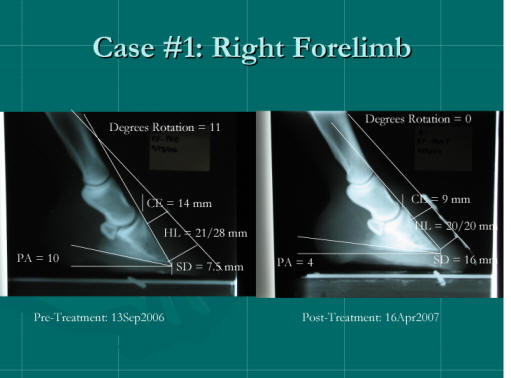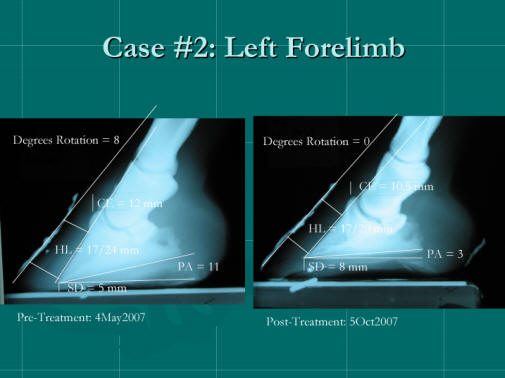Auburn Case Work/Documentation- Ivy and Pete Ramey update 3-14-09
Update:
July 2014 here is the first paper to come from our case work:
https://www.sciencedirect.com/science/article/pii/S0737080613006370Also, watch Dr. Taylor’s caudal foot video:
Read Dr. Taylor's chapters in http://www.hoofrehabstore.com/care-and-rehab-of-the-equine-foot/
Digital Cushion Development Bovine Study http://www.hoofrehab.com/A%20bovine%20model%20for%20equine%20digital%20cushion%20development.pdf
Predicting lateral cartilage and digital cushion mass and density file:///C:/Users/allyc/AppData/Local/Microsoft/Windows/INetCache/Microsoft%20Expression%20Web%204/LeahGuidrySummer2013Poster.pdf
Increasing mass of P2 and P3 http://www.hoofrehab.com/P2%20and%20P3%20development.pdf
Aunurn University Navicular Studies http://www.hoofrehab.com/NavStudy.html
Below are two of the cases from a study by Debra R. Taylor, DVM, MS, DACVIM (Auburn University College of Veterinary Medicine). She is recording and studying the results of natural hoof care on chronic laminitis cases. Ivy and Pete Ramey are currently traveling to Auburn every 3 weeks to expand the preliminary study (14 horses)- hopefully to include 50 horses [work load referred to Alex Sperandeo Nov '09]. The study has consistently shown rotation reversal, increased sole thickness and profound improvement in levels of soundness. Several case horses have also demonstrated reversal of distal descent of P3. The goal is to publish this data as a scientific paper; it would be the first time a successful method of reversing chronic laminitis has been published. If you have a laminitic horse you would like to add to the study (and can haul to the University) please contact Dr. Taylor at the vet school. Boarding is available at nearby farms. Link to Hoof Rehab Protocol
Parameters being tracked in the laminitis study: Coronary band-Extensor process distance (CE), Palmar Angle (PA), Breakover measurement, Sole Depth (SD), Cup (highest point of solar arch when viewed on radiograph), Horn: Lamellar zone HL (2 measurements), Bone angle, Degrees Rotation, Body Score and Obel Grade.
Click to read Debra Taylor's Report on the first 4 cases in the study [PDF with large picture files (5 meg total)- not recommended for dial-up connections].
Added 1-24-11 Updated numbers with 26 horses now in the study


Two hooves from the preliminary study (no dressing of the outer wall above common 'nail line'). Both were presented with perforations in the sole at the tip of P3 - Case 1 post-treatment at 7 months; Case 2 post-treatment at 5 months duration. So far, all of the horses in the study were Obel Grade 3-4 pre-treatment and Obel Grade 0 post-treatment. [Treatment by Debra Taylor, DVM and Alex Sperandeo.]
In addition to the chronic laminitis cases, Dr. Taylor is also documenting the results of natural hoof care on horses with caudal foot pain, including various navicular pathologies. This will hopefully result in a future published paper on the use of barefoot trimming, turnout environment, padded riding boots and caudal foot development to bring comfort and usability to "navicular horses." This could be another important 'first' -- at this time there is no scientifically proven method for long term restoration of soundness in horses with a diagnosis of either "navicular syndrome" or even "heel pain."
Teamwork at work- Out on an acute laminitis case with vet students on ambulatory rotations. Left photo: Debra Taylor DVM stresses the importance of the horse's diet and body score with the horse owner. Center 2 photos: Pete trims to relieve sheer stress on the laminae, then applies impression material to support P3 and cushion the sole. Right photo: Applying EasyCare Glue-on boots to maximize protection and provide axial loading so that a well connected wall can be grown. Ivy Ramey double loads the front right foot as the glue sets, while Pete smoothes out the impression material to keep debris out of the shoe.
Dr. Taylor has begun additional studies to prove out the clinical relevance of the research findings of Robert Bowker VMD, PhD. This summer she will use ultrasonography, cadaver dissection, histology, radiography, MRI and CT to establish parameters for evaluating lateral cartilage and digital cushion development [We want to thank Garrett Ford of EasyCare for providing funding for this project]. This preliminary cadaver study will pave the way for a planned study to track the caudal foot development in live horses over time using radiography, ultrasonography, MRI and/or CT. Currently, there are a limited number of veterinarians in the field that recognize the significance of internal foot development, and its ramifications to the horse's longevity and soundness. Experts in the field of hoof imaging, rarely address the anatomy, structure or health of the lateral cartilages, the digital cushion or heel depth when interpreting MRI results on horses with heel pain- in other words, half of the total volume of the foot is rarely taken into consideration. This study linking Bowker's cadaver studies to MRI, ultrasound and radiographic parameters should become critical to the future of lameness treatment and prevention.
4th year vet students at the Auburn College of Veterinary Medicine and a sedated horse with a neurological disorder.
Left photo: Pete races the clock; performing a large sole removal on negative palmar angle hind feet. Right photo: Dr. Taylor (kneeling at right) explains the procedure to the students. Collateral grooves are used as a guide to set P3 up on a more correct ground plane and to safely reduce the excess sole.
For detailed information on the treatment protocols used for the studies, read the Equicast, diet and trimming articles on www.hoofrehab.com. Vets and vet techs; 20 hours of AAVSB RACE approved CE are available with the DVD series Under the Horse.
People say hoof work is a blend of art and science.... Add 'contortionist' to the list when the horse is laying down!

